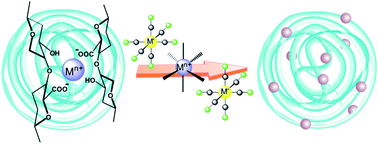Synthesis and study of Prussian blue type nanoparticles in an alginate matrix†
Abstract
A new approach for the synthesis of Prussian blue type

* Corresponding authors
a
Institut Charles Gerhardt Montpellier, UMR 5253 CNRS-UM2-ENSCM-UM1, Chimie Moléculaire et Organisation du Solide, Université Montpellier II, Place E. Bataillon, 34095 Montpellier cedex 5, France
E-mail:
joulia.larionova@univ-montp2.fr
Fax: +33 4 67 14 38 52
b
Institut Charles Gerhardt Montpellier, UMR 5253 CNRS-UM2-ENSCM-UM1, Matériaux Avancés pour la Catalyse et la Santé, ENSCM, 8 rue de l'Ecole Normale, 34296 Montpellier cedex 5, France
E-mail:
quignard@enscm.fr
Fax: +33 4 67 16 34 70
c Department of Physics, CICECO, University of Aveiro, 3810-193 Aveiro, Portugal
A new approach for the synthesis of Prussian blue type

 Please wait while we load your content...
Something went wrong. Try again?
Please wait while we load your content...
Something went wrong. Try again?
A. Tokarev, P. Agulhon, J. Long, F. Quignard, M. Robitzer, R. A. S. Ferreira, L. D. Carlos, J. Larionova, C. Guérin and Y. Guari, J. Mater. Chem., 2012, 22, 20232 DOI: 10.1039/C2JM33585A
To request permission to reproduce material from this article, please go to the Copyright Clearance Center request page.
If you are an author contributing to an RSC publication, you do not need to request permission provided correct acknowledgement is given.
If you are the author of this article, you do not need to request permission to reproduce figures and diagrams provided correct acknowledgement is given. If you want to reproduce the whole article in a third-party publication (excluding your thesis/dissertation for which permission is not required) please go to the Copyright Clearance Center request page.
Read more about how to correctly acknowledge RSC content.
 Fetching data from CrossRef.
Fetching data from CrossRef.
This may take some time to load.
Loading related content
